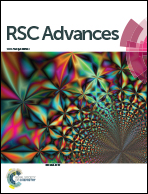Theoretical insights into the electroreduction mechanism of N2 to NH3 from an improved Au(111)/H2O interface model†
Abstract
An improved H coverage-dependent Au(111)/H2O electrochemical interface model is proposed in this paper, which is firstly used to study electroreduction mechanisms of N2 into NH3 at the thermodynamical equilibrium potential in cooperation with electronic structure analysis. The results show that the associative mechanism is more favorable on Au(111) and therein alternating and distal pathways may be able to parallelly occur in gas phase and the present simulated electrochemical interface. The initial N2 reduction into the N2H intermediate is the rate determining step, which may be able to be regarded as the origin of the observed experimentally high overpotential during N2 electroreduction. The presence of an electrochemical environment can significantly change the N2 reduction pathway and decrease the barrier of the rate determining step, which can be ascribed to the significant electron accumulation and interaction between N2 molecules and H2O clusters. The theoretical results display excellent consistency with the available experimental data, confirming the rationality of the present proposed electrochemical model. The comparison of the barrier between the hydrogen evolution reaction and rate determining step well explains why the activity of Au electrodes is usually unsatisfactory. Accordingly, a single descriptor can be proposed, in which an ideal electrocatalyst should be able to reduce the barrier for initial N2 electroreduction into N2H. In this way, N2 electroreduction pathways can be facilitated and the yield of NH3 can be enhanced. We believe that the present study can represent progress to study N2 electroreduction mechanisms from an improved electrochemical model.



 Please wait while we load your content...
Please wait while we load your content...